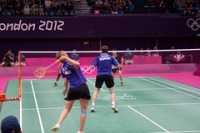
26 Apr Shuttlecock Injuries from Badminton Can Cause Permanent Eye Damage
MedicalResearch.com Interview with:
 Dr. Yi Liu
Dr. Yi Liu
Department of ophthalmology,
Beijing Tongren Hospital,
Beijing, P.R.China
MedicalResearch.com: What is the background for this study?
Response: Though rare, sports-related ocular traumas may result in devastating and disabling consequences. Badminton is popular in Southeast Asia, such as in Malaysia, Philippines, Indonesia, and China. It is in the leading cause list of sport-related ocular injury. Badminton related ocular injuries were also occurred and reported in western countries such as Canada, Australia. The popularity of badminton is partially because it is considered relatively safe, as it does not involve physical contact. The growing popularity of badminton has led to an increased incidence of physical and ocular injuries. Although the latter are uncommon, they can lead to significant ocular morbidity and some patients suffer a permanent decrease in vision, and even blindness.
We believe that the awareness of badminton-related ocular injuries is of great importance. The main purpose of this study was to summarize the clinical sports-related features of 85 patients with badminton related ocular injuries and made preventive recommendations to the general population from ocular injuries in badminton playing.
MedicalResearch.com: What are the main findings?
(1) We found that doubles players in the fore court were at the highest risk of ocular trauma due to being hit by either their partner or opponent, and the most frequent mechanism was that the injured player turned around to his partner as they were making the shot.
(2) We found that both the injured player and the instigator had usually not received any lessons from professionals.
(3) We found that none of the injured players and the instigators them use any eye protection during playing.
(4) We found that penetrating ocular injuries could occur in badminton playing, which were usually resulted from shattered glasses. Although relatively less frequent, penetrating ocular injuries was usually more serious and led to permanent vision loss.
MedicalResearch.com: What should readers take away from your report?
(1) Doubles players in the fore court must not turned around to their partner. This is the most common mechanism of ocular injury in badminton playing.
(2) The majority of badminton-related eye injuries occurred in doubles.
(3) Use of protective eyewear.
(4) Lessons from a professional player education for awareness of ocular trauma and adequate vision correction are highly recommended.
(5) Penetrating ocular trauma, usually caused by shattered glasses, is less common and more severe than non-penetrating trauma.
(6) Hyphaema is the most predominant injury and may cause angle recession and secondary glaucoma. Patients with angle recession need longtime follow-up. Patients with secondary glaucoma need lifelong follow-up and adequate treatment.
(7) Extra precautions should be taken by people with certain risk factors, such as history of intraocular surgery, high myopia, or those who are functionally one-eyed, when playing badminton.
MedicalResearch.com: What recommendations do you have for future research as a result of this work?
Response: We recommend doctors to follow patients with angle recession to investigate the incidence of future glaucoma.
Citation:
Jie Yu, Yan Chen, Jingpeng Miao, Meng Zhao, Caixia Keng, Xiaojie Wang, Jianjun Guo, Yi Liu. Doubles trouble-85 cases of ocular trauma in badminton: clinical features and prevention. British Journal of Sports Medicine, 2019; bjsports-2018-099496 DOI: 10.1136/bjsports-2018-099496
[wysija_form id=”3″]
[last-modified]
The information on MedicalResearch.com is provided for educational purposes only, and is in no way intended to diagnose, cure, or treat any medical or other condition. Always seek the advice of your physician or other qualified health and ask your doctor any questions you may have regarding a medical condition. In addition to all other limitations and disclaimers in this agreement, service provider and its third party providers disclaim any liability or loss in connection with the content provided on this website.
Last Updated on April 26, 2019 by Marie Benz MD FAAD
